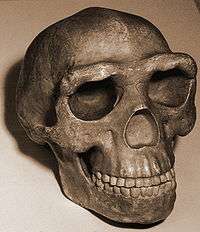Sagittal keel

The Sagittal keel (torus) is a thickening of bone on part or all of the midline of the frontal bone, or parietal bones where they meet along the sagittal suture, or on both bones. Sagittal keels differ from sagittal crests, which are found in some earlier hominins (notably the genus Paranthropus) and in a range of other mammals. While a proper crests functions in anchoring the muscles of mastication to the cranium, the keel is lower and rounded in cross-section, and the jaw muscles do not attach to it.
Sagittal keels occur in several early human species, most noticeably in Homo erectus and occasionally in Homo heidelbergensis. Most Homo sapiens groups have lost them, likely as part of the general trend toward thinning of the cranial bones to make room for larger brains during the Pleistocene.[1] However there is a very small portion of modern humans who have this, but its function and etiology are unknown. Patrick Stewart of Star Trek: The Next Generation and the martial artist Shi Yan Ming present good examples of modern humans (Homo sapiens sapiens) with this feature. Australian Aborigenes also possess it. The keel appear to be tied to general cranial robusticity, and are more common in adult men than in women, and absent in children.